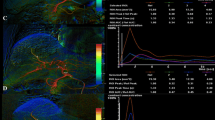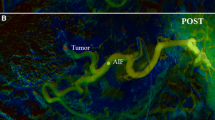Abstract
Purpose
To quantitatively measure the hemodynamic change of hepatic artery before and after transcatheter arterial chemoembolization (TACE) of hepatocellular carcinoma (HCC) by quantitative color-coding analysis (QCA).
Materials and Methods
This prospective study registered 64 consecutive HCC patients who underwent segmental or subsegmental TACE with epirubicin and lipiodol at level 2 or 3 of the subjective angiographic chemoembolization endpoint. QCA was used to determine the maximal density time (T max) of selected intravascular region of interest (ROI). Relative T max (rT max) was defined as the T max at the selected ROI minus the time of contrast medium spurting from the catheter tip. The rT max of hepatic arteries was analyzed before and after embolization.
Results
The pre- and post-treatment rT max of the landmarks at the treated segmental artery were 1.96 ± 0.48 and 3.14 ± 1.77 s, p < 0.001. According to the treated lobe, 30 patients were treated for the right lobe alone, and 8 patients were treated for the left lobe alone. The pre- and post-rT max of treated segmental artery were 2.06 ± 0.54, 3.34 ± 1.63 s, p < 0.001 and 1.89 ± 0.45, 2.68 ± 1.46 s, p = 0.12, respectively. The rT max of the proximal lobar hepatic arteries or proper hepatic artery had no significant change before and after TACE.
Conclusions
The QCA is feasible to quantify embolization endpoints by comparing the rT max in selected hepatic arteries before and after TACE. The rT max of treated segmental artery was significant prolonged after optimized procedures.


Similar content being viewed by others
References
Parkin DM, Bray F, Ferlay J, Pisani P. Global cancer statistics, 2002. CA Cancer J Clin. 2005;55(2):74–108.
Mazzaferro V, Regalia E, Doci R, Andreola S, Pulvirenti A, Bozzetti F, et al. Liver transplantation for the treatment of small hepatocellular carcinomas in patients with cirrhosis. N Engl J Med. 1996;334(11):693–9.
Llovet JM, Real MI, Montaña X, Planas R, Coll S, Aponte J, et al. Arterial embolisation or chemoembolisation versus symptomatic treatment in patients with unresectable hepatocellular carcinoma: a randomised controlled trial. Lancet. 2002;359(9319):1734–9.
Lo CM, Ngan H, Tso WK, Liu CL, Lam CM, Poon RT, et al. Randomized controlled trial of transarterial lipiodol chemoembolization for unresectable hepatocellular carcinoma. Hepatology. 2002;35(5):1164–71.
European Association for the Study of the Liver, European Organisation For Research and Treatment of Cancer. EASL-EORTC clinical practice guidelines: management of hepatocellular carcinoma. J Hepatol. 2012;56(4):908–43.
Belghiti J, Carr BI, Greig PD, Lencioni R, Poon RT. Treatment before liver transplantation for HCC. Ann Surg Oncol. 2008;15(4):993–1000.
Scatton O, Liddo G, Belghiti J. Liver transplantation for hepatocellular carcinoma: current topics in France. J Hepatobiliary Pancreat Sci. 2010;17(5):567–73.
Livraghi T, Meloni F, Morabito A, Vettori C. Multimodal image-guided tailored therapy of early and intermediate hepatocellular carcinoma: long-term survival in the experience of a single radiologic referral center. Liver Transpl. 2004;10(2 Suppl 1):S98–106.
Maeda S, Fujiyama S, Tanaka M, Ashihara H, Hirata R, Tomita K. Survival and local recurrence rates of hepatocellular carcinoma patients treated by transarterial chemolipiodolization with and without embolization. Hepatol Res. 2002;23(3):202–10.
Ikeda M, Maeda S, Shibata J, Muta R, Ashihara H, Tanaka M, et al. Transcatheter arterial chemotherapy with and without embolization in patients with hepatocellular carcinoma. Oncology. 2004;66(1):24–31.
Jin B, Wang D, Lewandowski RJ, Riaz A, Ryu RK, Sato KT, et al. Chemoembolization endpoints: effect on survival among patients with hepatocellular carcinoma. Am J Roentgenol. 2011;196(4):919–28.
Gaba RC. Chemoembolization practice patterns and technical methods among interventional radiologists: results of an online survey. Am J Roentgenol. 2012;198(3):692–9.
Lewandowski RJ, Wang D, Gehl J, Atassi B, Ryu RK, Sato K, et al. A comparison of chemoembolization endpoints using angiographic versus transcatheter intraarterial perfusion/MR imaging monitoring. J Vasc Interv Radiol. 2007;18(10):1249–57.
Jin B, Wang D, Lewandowski RJ, Ryu RK, Sato KT, Larson AC, et al. Quantitative 4D transcatheter intraarterial perfusion MRI for standardizing angiographic chemoembolization endpoints. Am J Roentgenol. 2011;197(5):1237–43.
Gaba RC, Wang D, Lewandowski RJ, Ryu RK, Sato KT, Kulik LM, et al. Four-dimensional transcatheter intraarterial perfusion MR imaging for monitoring chemoembolization of hepatocellular carcinoma: preliminary results. J Vasc Interv Radiol. 2008;19(11):1589–95.
Larson AC, Wang D, Atassi B, Sato KT, Ryu RK, Lewandowski RJ, et al. Transcatheter intraarterial perfusion: MR monitoring of chemoembolization for hepatocellular carcinoma—feasibility of initial clinical translation. Radiology. 2008;246(3):964–71.
Zhang XB, Zhuang ZG, Ye H, Beilner J, Kowarschik M, Chen JJ, et al. Objective assessment of transcatheter arterial chemoembolization angiographic endpoints: preliminary study of quantitative digital subtraction angiography. J Vasc Interv Radiol. 2013;24(5):667–71.
Kennedy AS, Kleinstreuer C, Basciano CA, Dezarn WA. Computer modeling of yttrium-90-microsphere transport in the hepatic arterial tree to improve clinical outcomes. Int J Radiat Oncol Biol Phys. 2010;76(2):631–7.
Davis B, Royalty K, Kowarschik M, Rohkohl C, Oberstar E, Aagaard-Kienitz B, et al. 4D digital subtraction angiography: implementation and demonstration of feasibility. Am J Neuroradiol. 2013;34(10):1914–21.
Parry PV, Ducruet AF. Four-dimensional digital subtraction angiography: implementation and demonstration of feasibility. World Neurosurg. 2014;81(3–4):454–5.
Acknowledgments
Taipei Veterans General Hospital-National Yang-Ming University- Excellent Physician Scientists Cultivation Program, No. 103-V-B-056. Taipei Veterans General Hospital and Siemens, No. T1100200.
Conflict of interest
Yi-Yang Lin, Rheun-Chuan Lee, Hsiuo-Shan Tseng, Chien-An Liu, Wan-Yuo Guo, and Cheng-Yen Chang have no conflict of interest.
Statement of Informed Consent
Informed consent was obtained from all individual participants included in the study.
Statement of Human Right
All procedures performed in studies involving human participants were in accordance with the ethical standards of the institutional research committee and with the 1964 Helsinki declaration and its later amendments or comparable ethical standards.
Author information
Authors and Affiliations
Corresponding author
Rights and permissions
About this article
Cite this article
Lin, YY., Lee, RC., Tseng, HS. et al. Objective Measurement of Arterial Flow Before and After Transcatheter Arterial Chemoembolization: A Feasibility Study Using Quantitative Color-Coding Analysis. Cardiovasc Intervent Radiol 38, 1494–1501 (2015). https://doi.org/10.1007/s00270-015-1111-6
Received:
Accepted:
Published:
Issue Date:
DOI: https://doi.org/10.1007/s00270-015-1111-6




